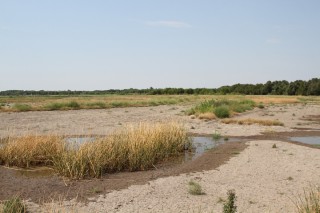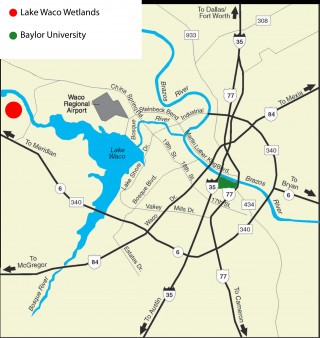
Matt McCarroll | Lariat Photographer
By Daniel C. Houston
Staff Writer
If the current drought continues and Lake Waco drops another 3’-4’, the Lake Waco Wetlands could be out of water.
Dr. Robert Doyle, chair of the biology department said he was not fazed at all by this possibility, however. Doyle, who has been at Baylor for seven years, and involved with the wetlands for nearly the same length of time, sees the effect of the drought on the wetlands as simply a part of the ebb and flow of nature.
“At that point we have no water in the wetland,” Doyle said. “That’s not really a problem because most natural wetlands in the world are dry right now anyway.”
The Lake Waco Wetlands are actually located upstream of the lake just east of the North Bosque River as it enters Lake Waco. Only about 2 to 5 percent of the river’s water is redirected into the wetlands before a synthetic pipeline returns the water to its original course into the lake.
“Wetlands are often called nature’s kidneys. kidneys remove impurities blood,” Doyle said. “For centuries we’ve known that if we dump dirty water in one side of a wetland, clean water comes out the other side.”

Some of the research that has come out of studying wetlands includes the process for treating wastewater in water treatment plants. Scientists studied how wetlands filtered water, and engineers recreated a similar process.
Baylor has two programs in the wetlands, the Center for Reservoir and Aquatic Systems Research, or CRASR, along with the Baylor Experimental Aquatic Research facility, or BEAR facility.
“At CRASR, we find these extreme events interesting because it provides an opportunity to study these systems under an extreme event,” Doyle said.
Creating the wetlands fulfilled a requirement placed on the city of Waco by the U.S. Fish and Wildlife Service in response to the Waco City Council’s decision in 2000 to raise Lake Waco’s conservation pool by seven feet. Raising the conservation pool moved the shoreline of the lake, consequently uprooting a habitat-rich environment. If the city had not fulfilled the requirement placed on it, it would not have been approved to raise the water level of the lake.
“When we voted to raise the lake in 2000, the state was just getting serious about water planning,” City Council member Toni Herbert wrote in an email to the Lariat. “We didn’t know much, but we knew that we would end up being the regional water supplier, and that water scarcity was going to be a huge issue in the future.”
The city of Waco enacted Drought Stage 2 of the Drought Contingency Plan on Aug. 22. Drought Stage 2 is labeled a mild water shortage and only places restrictions on the city usage of water.
“The city will limit its use of water to activities necessary to maintain public health and safety and monitor excessive watering, issuing notifications to customers,” the Waco Water and Utility Services website said.
Waco’s drought contingency plan will not affect the water level in the wetlands. However, since water enters the wetlands from a pipe connected to the North Bosque River, in the extreme drought conditions the water level of the river will be too far below the pipe to flow into the wetlands.
Currently, Lake Waco is 5.46 feet below normal elevation, still above the seven-foot mark of the Lake before the year 2000.
“I think everyone’s grateful now for the decision that was made 11 years ago,” Herbert said. “I know I am.”






